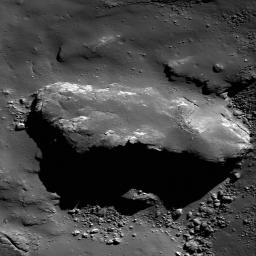
|
Ejecta in Tycho Crater
- Click the image above for a larger view
- Full-Res JPEG (1000 x 1000) (146.3 kB)
- Full-Res TIFF (1000 x 1000) (1.0 MB)
Caption:
320 meter (1050 feet) block of ejecta in Tycho crater covered by a veneer of impact melt. Image width is 370 meters (1214 feet), LROC NAC 142334392RE.
Tycho crater is a Copernican age crater (85 kilometers, or 53 miles, diameter) located at 43.3°S, 11.2°W. It is named for the 16th century Danish astronomer Tycho Brahe and is one of the most visible features on the near side of the Moon. Its ray system is so obvious and widespread that Apollo 17 astronauts sampled its ejecta, over 2000 kilometers (1243 miles) away from the crater. Scientists dated the Tycho samples at about 110 Ma. We also have surface views of Tycho's ejecta blanket taken by the Surveyor 7 soft lander.
Background Info:
NASA's Goddard Space Flight Center built and manages the mission for the Exploration Systems Mission Directorate at NASA Headquarters in Washington. The Lunar Reconnaissance Orbiter Camera was designed to acquire data for landing site certification and to conduct polar illumination studies and global mapping. Operated by Arizona State University, LROC consists of a pair of narrow-angle cameras (NAC) and a single wide-angle camera (WAC). The mission is expected to return over 70 terabytes of image data.
Cataloging Keywords:
| Name | Value | Additional Values |
|---|---|---|
| Target | Moon | |
| System | Earth | |
| Target Type | Satellite | |
| Mission | Lunar Reconnaissance Orbiter (LRO) | |
| Instrument Host | Lunar Reconnaissance Orbiter | |
| Host Type | Orbiter | |
| Instrument | Lunar Reconnaissance Orbiter Camera (NAC) | |
| Detector | Narrow Angle Camera (NAC), Wide Angle Camera (WAC) | |
| Extra Keywords | Crater, Grayscale, Impact | |
| Acquisition Date | ||
| Release Date | 2010-12-09 | |
| Date in Caption | ||
| Image Credit | NASA/GSFC/Arizona State University | |
| Source | photojournal.jpl.nasa.gov/catalog/PIA13694 | |
| Identifier | PIA13694 | |
